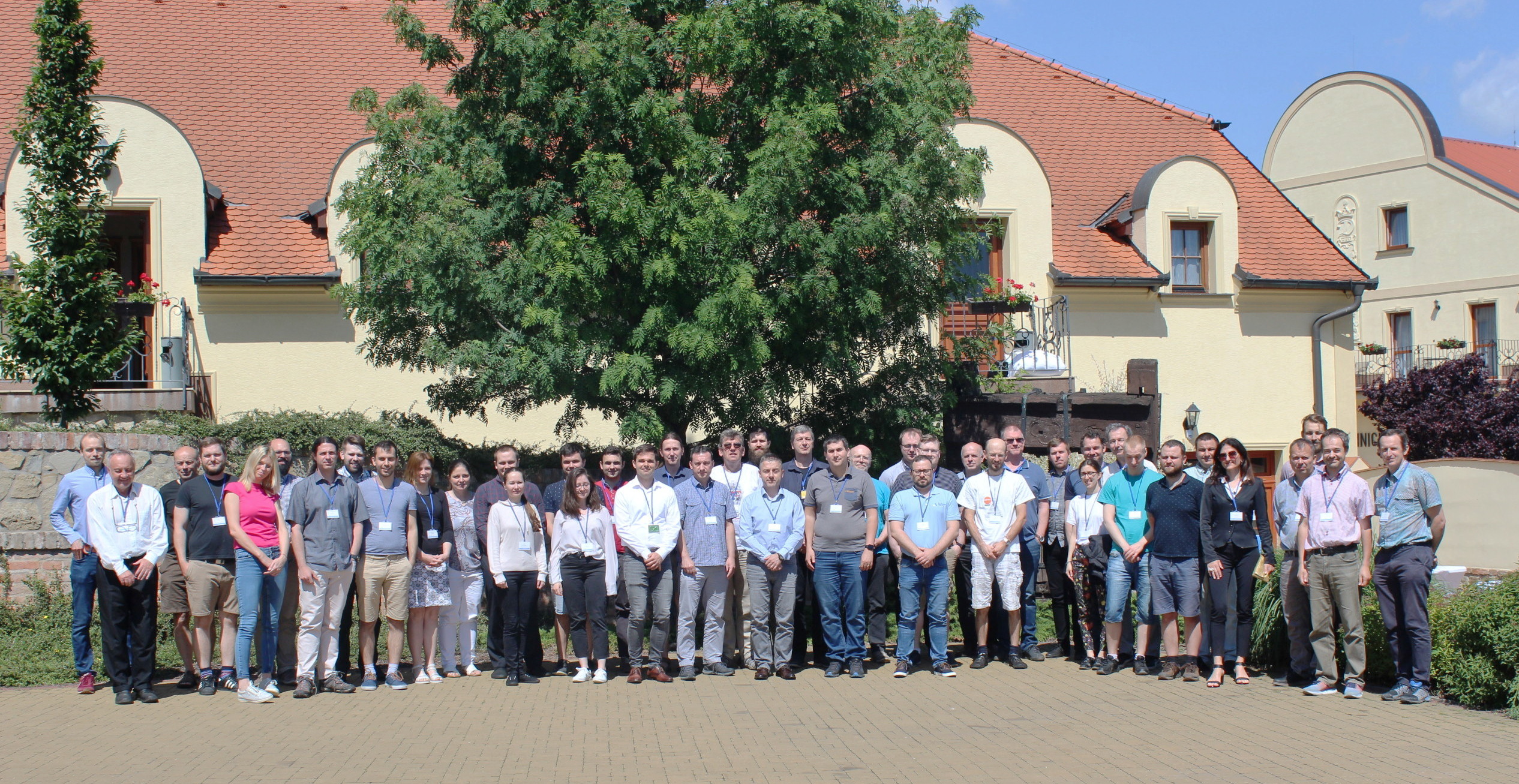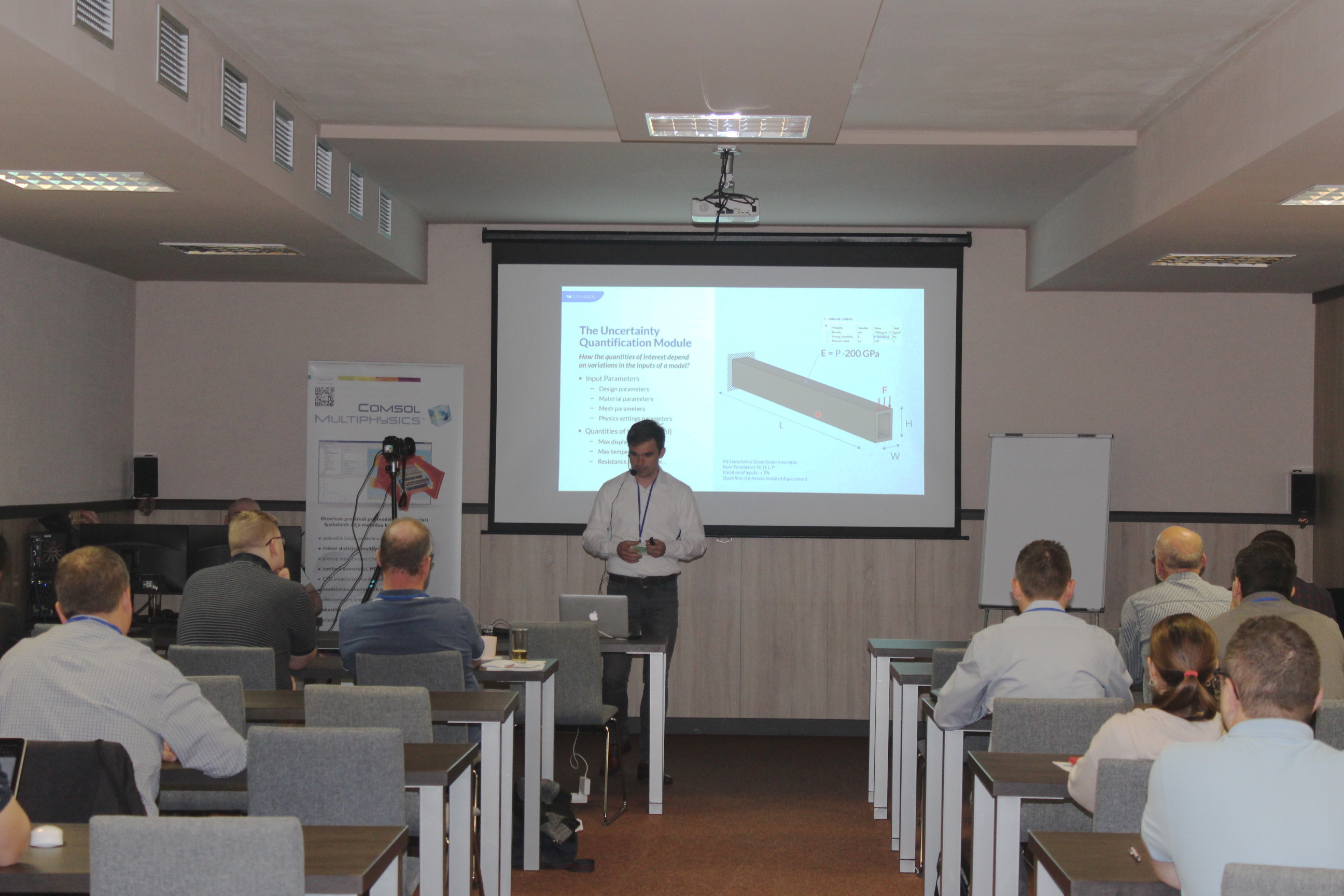
COMSOL MULTIPHYSICS 2022 CONFERENCE
26. – 27. 5., winery U Kapličky, Zaječí
46 people attended the conference in person and 43 people watched online. Thank you to all participants!
Already the 6th year of the COMSOL Multiphysics Conference, I would call it a „connecting“ year in the eyes of the organizer. This is also the function of distributors. We meet with many teams from companies and academic workplaces, and more than once it occurs to us – these do what others lack. Meetings like the one we organize are an ideal opportunity to connect teams whose common language is mathematical simulations. This year we were very successful, so for example, CFD specialists from Prague connected with a team looking for CFD modelers in Brno.
Although the conference started on the morning of Thursday, May 26, many guests arrived at the hotel a day earlier to save themselves an early morning trip. Pre-conference Wednesday is traditionally cheerful. From the afternoon, guests with conspicuous conference badges crowded the hotel bar, and everything graduated with a joint dinner, after which discussions were held until the early hours of the morning. I can say for myself that many current topics – professional and non-professional – were discussed. In this, one face-to-face conference will replace all the possible online meetings of the world. Unfortunately, the hotel's restaurant and bar does not count on such intensive discussions. They officially close at 10pm and unofficially we ordered out at midnight. They stood and sat outside for the next hour and a half. However, supplies were running low and we said goodbye around half past two. The guests from the Mendel University in Brno lasted the longest. Not long after saying goodbye, we met them again, to our surprise, wandering around looking for a really badly marked room. And so our historically latest (or earliest?) technical support was born – we escorted them to their room.
The Thursday program was packed this year. After CFO Peter Byron's opening remarks, I presented a new tool for quantifying uncertainty in results in just 20 minutes. This was followed by two live performances by special guest Linus Andersson from COMSOL. Before the break, Linus walked us through the extensive possibilities of modeling acoustics in COMSOL Multiphysics. He accompanied the narration with a demonstration of a model of parking sensors. Linus first calculated the radiation characteristics of a single sensor, which was used for a model car backing into the pillars. However, it was only after the break that Linus pulled out a real ace up his sleeve, when in a presentation focused on modeling user-defined equations, he demonstrated a mosquito flight simulation in two ways with the same result. The Czech Republic and Slovakia are said to be relatively characteristic in that we have many users implementing their own equations, and the subsequent rich discussion only confirmed this. After lunch, our new colleague Radko Kozakovič introduced us to a demonstration of the compressor movement and deformation model. Radko focuses on structural mechanics, dynamics and mechanism simulations. Then Matouš Lorenc took the microphone, who demonstrated the new and unrivaled capabilities of COMSOL in the field of processing realistic computing domains from a scanner, MRI or CT. He also prepared a sample, specifically a femur model. After Matouš's successful contribution, Radko replaced him with a second contribution, this time about the model of pressures, velocities and deformations of the heating system represented by beam elements in the Pipe Flow Module. The last online presentation on Thursday was about simulating the risk of condensation. I tried to implement the Auditorium with the options of the Heat Transfer Module, focusing on the modeling of the humidity-temperature field. I showed a model for calculating the humidity in the perimeter wall of the house and in more detail the calculation of the risk of condensation in an electronic device located in the outdoor areas of the airport in New York. From the formal program, we still had time to negotiate with the teachers at the coordination meeting with the universities, but time was running out and soon we left for the bus that took us to the U Bednářů wine bar in Pavlov. After a funny and fairly decent tasting led by Mr. Radim Nekvasil, we returned to Zaječí at midnight, where the fun continued in unmanaged groups. For example, with guests from CTU, the Leoni company, and the aforementioned crew from Mendel University, I hiked to the Daliborka lookout tower at night for the first time ever. True, the view is more interesting during the day, but the route was more interesting at night. Especially after the wine tasting. All survived.
Friday's program surprised me the most. Dušan Nešpor from the company TESCAN started a constellation of great user contributions. Dušan presented a simulation of a plasma source. He very ingeniously managed to simplify the task and gain the necessary insight into the complicated physics, thus demonstrating a true mastery of mathematical modeling. The second in line to speak was the distinguished guest, who was Professor Bohuslav Gaš from Charles University. The professor was able to clearly introduce those present to his research in the field of physical chemistry. The paper dealt with the Mathematical model of electromigration in nanoscale and was part of the research he published in a prestigious scientific journal. His model was even chosen for the cover. He was replaced by Petr Bartoň from the Institute of Plasma Physics AVČR, where with COMSOL they simulate probably the most complicated geometries that I have seen in my career so far. The goal of the presentation was to show the result of a program that Petr briskly wrote in JAVA code for the purpose of automatic selection of thousands of surfaces of different sizes for the boundary condition in the bowels of the tokamak. The next lecturer was Štěpán Papáček, whose work was the simulation of processes with two time scales using Equation-Based Modeling. Before the break, Jakub Koláček, a gifted student from the Faculty of Chemistry at BUT in Brno, also had time to give his presentation. Kuba showed how physical/chemical processes can be brought closer to students using an app. His tutorial app Simulating a battery made from a lemon was a nice diversion. After the break, similarly interesting guests from Liberec, namely Petr Rálek and Aleš Balvín, took the microphone. The first-named presented a numerical model of a deep geothermal heat exchanger from the Litoměřice case study, the second-named showed his first simulation in COMSOL Multiphysics – Transport of radionuclides from a container with spent radioactive waste through a bentonite barrier. At the end of the conference, we included a workshop – Introduction to COMSOL Multiphysics modeling on the rather unusual task of topological optimization of a cooler for a 3D printer. All presentations can be downloaded in our archive. After the final thanksgiving, we met for the last time at lunch, where we said goodbye and then went home to all corners of the Czech Republic and Slovakia. We hope you enjoyed the meeting as much as we did and we will meet again in a year.
We look forward to seeing you in 2023 at a similar date at the end of May.
Martin Kožíšek

